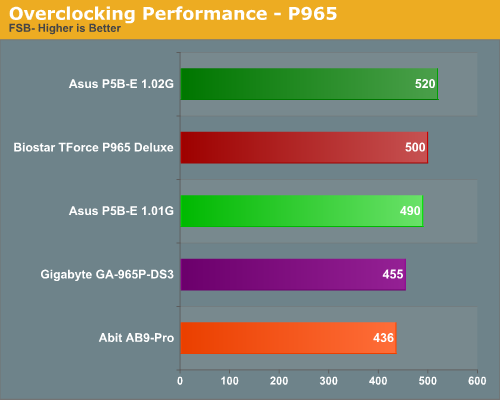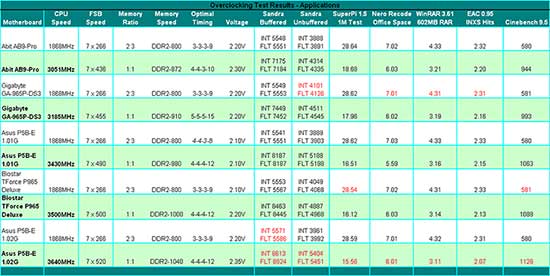Intel P965: Mid-Range Performance Sector Roundup
by Gary Key on October 20, 2006 9:00 PM EST- Posted in
- Motherboards
Overclocking Performance

We have already reviewed the overclocking capabilities of each board in detail during our review of the boards' feature sets if addtional information is required about the results. As a recap our ASUS P5B-E 1.02G motherboard is our top overclocking board. It is able to overclock further with our GEIL PC2-6400 memory than the ASUS P5B-E 1.01G board due to the additional memory voltage options. The Biostar TForce P965 board is limited to 500FSB due to its BIOS options. Our Gigabyte GA-965P-DS3 is limited to the 450FSB range due to issues overclocking our Micron D9 1GB modules and the Abit AB9-Pro is just limited at this time. We will now take a look at how our boards performed in a few of our standard benchmarks while overclocked.
Our end results are not that surprising as the higher you overclock a system the greater its performance will be and in this case that means the ASUS P5B-E 1.02G walks away with the trophy. In our application benchmarks that tend to be very CPU intensive we see the benefits of overclocking as our Nero Recode test shows an improvement of 16% on average with our WinRAR tests showing upwards of a 36% increase in performance. Our audio encoding test only showed an improvement of 11% but this is due to the fact that the CPU was waiting on the optical drive during the encoding process as it takes two minutes and three seconds to extract the audio files. In our Sandra memory results we see the Gigabyte GA-965P-DS3 having the highest Unbuffered results which directly translates to its class leading performance in our benchmarks. We also took notice of the very consistent performance from the Biostar TForce P965 Deluxe board which has the second highest Sandra Unbuffered test results.
In our gaming benchmarks we see differences of 7% in Quake 4, up to 38% in Battlefield 2, and 59% in the older Serious Sam II title. This trend shows a definite improvement in the CPU/GPU balanced titles with little improvement in a title like Quake 4 that is already becoming GPU limited at 1280x1024. We implemented 4xAA in Quake 4 and the game shows no real differences in performance once it becomes GPU limited. Battlefield 2 still shows a 22% improvement but the spread between the Abit board and the ASUS 1.02G board is only 1% even though there is a 19% difference in the overclocking speed of the boards. Serious Sam II becomes GPU limited in a hurry when implementing 4xAA/8xAF settings although the frame rates are still very good.
Our opinion is that unless you are benchmarking to impress your friends and colleagues or are not GPU limited then there are few real gaming advantages to overclocking a system with the latest components. This basically means that to a certain degree you should invest in a very good GPU first and then start looking at the platform components based upon your timeline for keeping the system. Over time overclocking can become advantageous as you upgrade the GPU and simply overclock the system to improve CPU and memory performance. This can help extend the life of your main system components while allowing you to spend your money wisely during an upgrade cycle. Of course, there are those of us who throw this entire theory out the window (Ed: the author does this everyday!) every time a new component is introduced.

We have already reviewed the overclocking capabilities of each board in detail during our review of the boards' feature sets if addtional information is required about the results. As a recap our ASUS P5B-E 1.02G motherboard is our top overclocking board. It is able to overclock further with our GEIL PC2-6400 memory than the ASUS P5B-E 1.01G board due to the additional memory voltage options. The Biostar TForce P965 board is limited to 500FSB due to its BIOS options. Our Gigabyte GA-965P-DS3 is limited to the 450FSB range due to issues overclocking our Micron D9 1GB modules and the Abit AB9-Pro is just limited at this time. We will now take a look at how our boards performed in a few of our standard benchmarks while overclocked.
 |
 |
| Click to enlarge |
Our end results are not that surprising as the higher you overclock a system the greater its performance will be and in this case that means the ASUS P5B-E 1.02G walks away with the trophy. In our application benchmarks that tend to be very CPU intensive we see the benefits of overclocking as our Nero Recode test shows an improvement of 16% on average with our WinRAR tests showing upwards of a 36% increase in performance. Our audio encoding test only showed an improvement of 11% but this is due to the fact that the CPU was waiting on the optical drive during the encoding process as it takes two minutes and three seconds to extract the audio files. In our Sandra memory results we see the Gigabyte GA-965P-DS3 having the highest Unbuffered results which directly translates to its class leading performance in our benchmarks. We also took notice of the very consistent performance from the Biostar TForce P965 Deluxe board which has the second highest Sandra Unbuffered test results.
In our gaming benchmarks we see differences of 7% in Quake 4, up to 38% in Battlefield 2, and 59% in the older Serious Sam II title. This trend shows a definite improvement in the CPU/GPU balanced titles with little improvement in a title like Quake 4 that is already becoming GPU limited at 1280x1024. We implemented 4xAA in Quake 4 and the game shows no real differences in performance once it becomes GPU limited. Battlefield 2 still shows a 22% improvement but the spread between the Abit board and the ASUS 1.02G board is only 1% even though there is a 19% difference in the overclocking speed of the boards. Serious Sam II becomes GPU limited in a hurry when implementing 4xAA/8xAF settings although the frame rates are still very good.
Our opinion is that unless you are benchmarking to impress your friends and colleagues or are not GPU limited then there are few real gaming advantages to overclocking a system with the latest components. This basically means that to a certain degree you should invest in a very good GPU first and then start looking at the platform components based upon your timeline for keeping the system. Over time overclocking can become advantageous as you upgrade the GPU and simply overclock the system to improve CPU and memory performance. This can help extend the life of your main system components while allowing you to spend your money wisely during an upgrade cycle. Of course, there are those of us who throw this entire theory out the window (Ed: the author does this everyday!) every time a new component is introduced.










62 Comments
View All Comments
JarredWalton - Saturday, October 21, 2006 - link
Oh, trust me, Gary tested with a LOT of RAM types and manufacturers. However, for the *benchmarks* he settled on one specific set of DIMMs. I think he's trying to put together some information on how the various boards worked with other RAM (see above comment from Gary). Cheers!stmok - Saturday, October 21, 2006 - link
LOL...I think its more like: "What the hell were the Abit engineers thinking?!"Based on your experiences, do you know if the Analog Devices AD1988A HD Audio Codec works in Linux? I wouldn't mind going for the ASUS P5B-E at the end of the year.
And finally, is the rev 1.02G mobo available now? Or in a few months time?
Gary Key - Saturday, October 21, 2006 - link
The 1.09 ADI AD1988A drivers worked fine in SUSE 10.1. Realtek has better support at this time but ADI seems to be catching up. Believe it or not, but we booted every board with SUSE 10.1 just to make sure they went to the desktop. We might even do a once in a while look at Linux down the road.
xsilver - Saturday, October 21, 2006 - link
what is the range of overclocking possible with pc6400 ram?without dividers? with dividers?
Gary Key - Saturday, October 21, 2006 - link
Good question, depends on the PC2-6400 RAM. We are working on something right now to answer your question with a few different modules.xsilver - Sunday, October 22, 2006 - link
probably something standard like corsair VS or something priced very similar if there is better performance elsewherexsilver - Sunday, October 22, 2006 - link
also I would assume that 1gig vs. 2gig makes no difference but if it does, it would be good to know.Madellga - Saturday, October 21, 2006 - link
Excellent review Gary. I also look forward for the round 2 and also for a 975/ATI/Nvidia reviews.Please try to mention the Vmch used for the overclocking results, as this says a lot about the motherboads also.
Gary Key - Saturday, October 21, 2006 - link
I am setting up a overclocking settings table and will try to show some additional results with different memory types that we used in testing. I have no idea when this will be finished. ;-)Ryan Norton - Saturday, October 21, 2006 - link
This article is terrific-- now I just need to read the high-end part and I can finally put together a Core 2 Duo system.Will the DS4 be included in the high-end guide? I don't want a DQ-6 because the copper backplate under the processor socket would prevent installation of a Scythe Ninja heatsink.
Are the AHCI issues going to stay the way they are, with needing to load the drivers from a floppy disk during Windows install, or are there any P965 boards that don't require "an engineering degree and a day off" as you guys said?